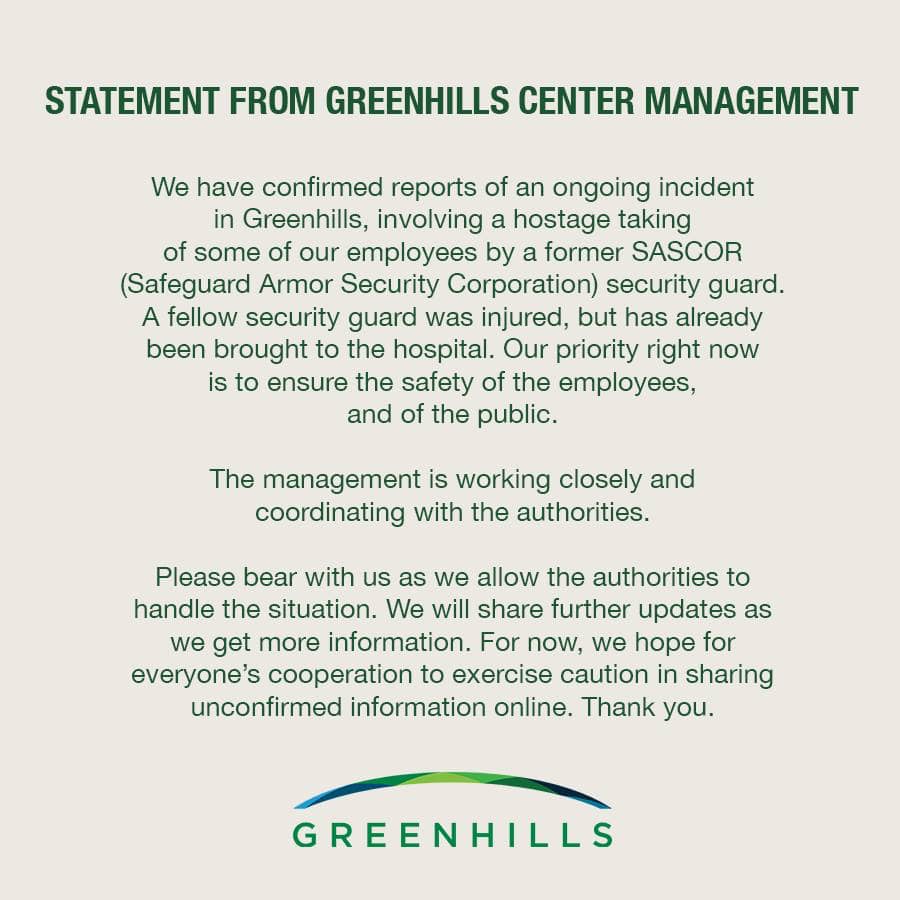Hostage-taking crisis in San Juan mall: Media could have done better

SADLY, HOSTAGE-taking incidents are not new in this country; there have been enough to teach the police how to handle these situations so as to prevent more harm.
But the episode on March 2, when a dismissed security guard took out his grievance on employees of Virra Mall (V-Mall) in San Juan, revealed how much there still is to be learned not only by the police, but also by the media.
The coverage of any crisis places the media in a hot spot, when reporters have to make quick decisions about which of their obligations take priority: getting the news to the audience as quickly as possible, or preventing harm at all possible levels.
Alchie Paray, disgruntled over losing his job, took matters into his own hands and held dozens hostage. He was armed with a pistol and a grenade. Paray was fired by his agency, Safeguard Armor Security Corporation, after going absent without leave. According to reports, he did so because of the company’s allegedly unfair labor practices.
Media began reporting the hostage situation around noon, with TV initially reporting it as breaking news and flash reports. TV news utilized video clips uploaded in social media to show the situation in the mall, while reporters on site narrated what was known so far via phone interview or live broadcast. The media also interviewed authorities, such as police officials and San Juan Mayor Francis Zamora for additional information. Reports were careful not to air any sensitive information that may affect the outcome.
The evening newscasts followed up with more of the same treatment, reviewing what had happened as well as updating the public with current information. Negotiations were still ongoing during the newscast. The standoff ended after more than nine hours, luckily ending with no other casualties.
The coverage of the incident applied the lessons learned from the disastrous coverage of the Quirino Grandstand crisis in 2010. But the lapses revealed weaknesses on the part of the police.
Lapses, points for learning
As media reports noted, the police allowed Paray to speak to the press right after he released the hostages at around 8:00 p.m.
The presser was actually a part of the negotiation process – a point which became apparent to the press only after the crisis had ended. Paray said he would give up the hostages if he was allowed to talk to the media. Mayor Zamora and police authorities justified the decision, arguing that it had to be done so that the hostages could be released, and to allow Paray to calm down which would make subduing him much easier. But the authorities should have advised the media about this decision, letting them know that they had become part of the negotiations.
Allowing the hostage taker to talk to the media gave him the upper hand in presenting the facts of the case. A hostage crisis veteran interviewed by 24 Oras described it as a mistake on the part of the crisis management team, which included the responding policemen. The point: all participants in a negotiation must be “well-briefed” on the plan so that they are aware and prepared for any eventualities.
Not knowing the condition, the media should have insisted that they would talk to Paray but it would not be aired live, and that reporters would present his side as they saw fit. The media did the right thing by not airing it live, instead reporting it only with edited clips.
Unfortunately, some reports lacked the caution necessary to prevent presenting Paray as a sympathetic figure, maybe even someone who was acting for the good of his co-workers.
For example, Manila Bulletin’s March 3 report’s headline read: “San Juan hostage-taker took up the cudgels for fellow security guards.” Not only does the report paint him as a hero, it also invites public sympathy, somehow leading others to think of his actions as justifiable. This point was proven a week later by a report of the Philippine Daily Inquirer on March 11, which noted that strangers have been offering support and even financial assistance for Paray’s bail.
Paray is pitiful, but media cannot let slip the fact that he was willing to shoot at an innocent person, hold others who had nothing to do with his complaint and suffer the terror of being held at gunpoint. Taking the law in his own hands, he crossed the line which must be upheld in the public eye. This is a path that cannot be held up in any positive light as it would encourage and justify others into doing the same.
Media’s agenda-setting power is far-reaching. For this reason, members of the media must always be mindful of the impact of their reports, which can easily influence public opinion. Any story on the plight of Paray still have to emphasize that he rightly faces trial and must be judged in court.
Leave a Reply